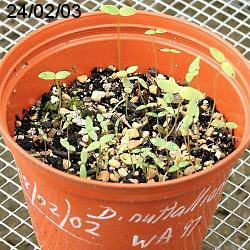
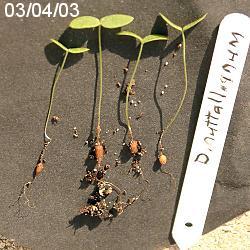
| Return to American Species Contents List |
| North American Delphinium Species |
D. nuttallianum, also known as the upland larkspur, is widely distributed throughout the mountainous regions of western America and British Columbia in Canada. It is typically a plant of open coniferous woods, grassy sage scrub, meadow edges and well-drained streamsides at 300 - 3500m, where it flowers in spring or early summer. The seed we have grown was collected from plants in theColumbia River Gorge region.
Seeds were sown in winter 2002 on the surface of a peat-based multipurpose compost mix in a small pot and then covered lightly with compost and a layer of fine grit. The pot was left outdoors and exposed to the winter weather. In the UK this means spells of rainy weather, some overnight frost or longer spells of frosty weather. Few seeds germinated after the first winter but after after a second winter there was extensive germination. Like many American delphiniums with tuberous roots, seedlings have a pair of seed leaves at the top of a single stalk. A root tuber develops at the junction between the leaf stalk and the root before any true leaves form, as seen in the picture below.
 |
 |
True leaves develop from the top of the tuber but most seedlings transplanted at this stage failed to develop further and became dormant or died. For seedlings surviving to a third season, true leaves emerge from the surface of the compost at the end of winter, as seen below, and the plants can be safely moved into individual pots. In 2004, these seedlings developed a few leaves before ceasing growth and becoming dormant in late spring.
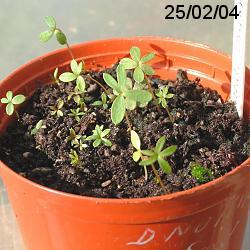 |
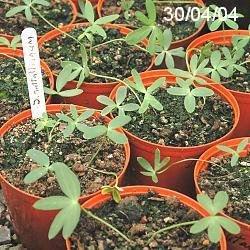 |
In 2005, two plants of the batch were obviously growing more strongly with larger leaves and a stem with a few flowers. In 2006 several more plants developed stems with a few flowers in early May. These went on to produce seeds before the plants became dormant.
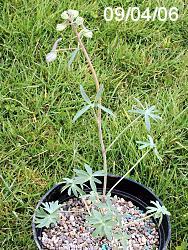 |
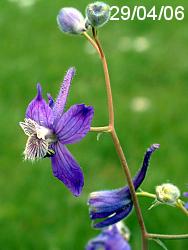 |
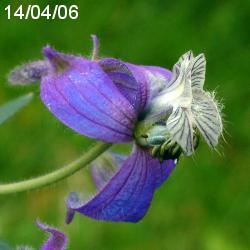 |
Notable features of the flowers are the short hairs covering the external surface of the sepals, which reflex back as the flowers age, and the purple-blue veining of the white petals that have a pronounced cleft at the apex.
The pots containing plants of D. nuttallianum were left in a cold frame with a collection of other delphiniums species. One consequence was that seeds of another species dropped into the pots and in 2006 this led to an unexpected later flush of new growth of a dwarf delphinium with larger fleshy leaves. These were plants of D. orfordii (D. decorum?) that provided pretty flowers of very different character in June.
As amateur gardeners we probably do not manage the plants in an ideal way but four years from sowing to significant flower production seems rather a long time. It would be interesting to know how long this takes for plants in the wild and how many seasons the plants survive.
| Return to American Species Contents List |
| Return to Species cover page |